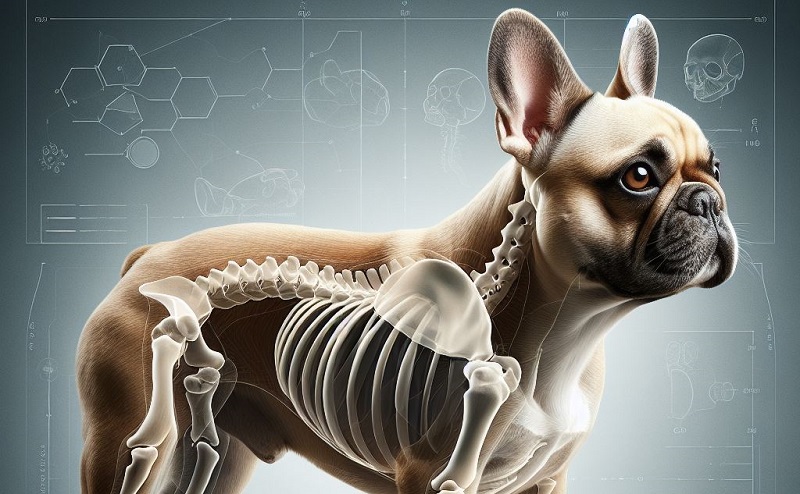Neck Problems in French Bulldogs
Neck problems are common in French Bulldogs. Understanding these problems will help you better care for your French Bulldog and seek the right veterinary help to ensure their health and well-being.

Written By
Dan Harrison
Editor

Co-Written By
David Anderson
Writer

Reviewed By
Penny Worthington
Health

Research By
Sammi Slater
Researcher
Page Last Updated: 10th May 2024
On this page
Quickly find and read what interests you the most using the links below:
Table of contents:
French Bulldog Anatomy
The French Bulldog’s neck anatomy, characterised by its strength and vulnerability, is pivotal to its unique appearance and physiological function.
This breed, known for its distinctive brachycephalic features, relies on a well-structured neck to support its large head relative to body size.
The neck comprises various critical components, each significantly impacting the dog’s overall health and functionality.
Musculature
The musculature of the French Bulldog’s neck is notably strong and developed, a necessary adaptation to counterbalance the weight of its large head.
This muscular structure is not just about brute strength; it also ensures fluid movement and stability, allowing for a wide range of head motions while maintaining posture.
The robust neck muscles are essential for everyday activities, from feeding to interacting with their environment and other dogs.
Vertebrae
Comprising seven cervical vertebrae, similar to other canine breeds, the French Bulldog’s neck vertebrae are subjected to increased stress due to the breed’s head size and shape.
This stress can impact the neck’s flexibility and range of motion, potentially leading to stiffness or discomfort.
The unique demands on these vertebrae highlight the need to carefully monitor neck health and mobility in French Bulldogs.
Trachea
The trachea runs the length of the neck and is particularly important in brachycephalic breeds like the French Bulldog.
Their trachea may be narrower or predisposed to conditions such as tracheal collapse, significantly impacting breathing.
The breed’s airway structure necessitates a careful approach to exercise and stress, ensuring that breathing is not unduly compromised.
Blood Vessels and Nerves
The neck’s blood vessels and nerves are crucial for the overall functioning of the head and front limbs.
The carotid artery and jugular vein are major blood vessels in the neck that transport blood to and from the head.
Meanwhile, the cervical nerves emanate from the spinal cord, facilitating sensory and motor functions.
This intricate network supports everything from facial expressions to the movement of the front limbs.
The French Bulldog’s neck anatomy, combined with robust musculature, critical vertebral structure, a delicate trachea, and essential blood vessels and nerves, underlines the breed’s unique physical composition.
This anatomy contributes to the French Bulldog’s appearance and susceptibility to specific health challenges.
IVDD
IVDD occurs when the intervertebral discs, which generally act as shock absorbers for the spine, begin to degenerate, lose their elasticity, or herniate.
This degeneration or herniation can lead to the discs pressing against the spinal cord or nerve roots, causing significant pain, discomfort, and, in severe cases, paralysis.
The neck (cervical) region is often affected in French Bulldogs, drastically impacting their quality of life.
Symptoms of IVDD
The symptoms of IVDD can vary in severity, from mild discomfort to severe impairment:
- Pain: One of the earliest signs of IVDD. Dogs may show discomfort or pain when their neck is touched or when they try to move it.
- Reluctance to Move: Dogs with neck pain due to IVDD may become hesitant to jump, play, or even move about as usual.
- Vocalisation When Touched: Vocalising in pain when touched or picked up is a clear sign of discomfort.
- Paralysis: In severe cases, IVDD can lead to paralysis, which may occur if the spinal cord is significantly compressed. This can manifest as partial or complete paralysis of the limbs, depending on the location and extent of the disc herniation.
Diagnosis of IVDD
Diagnosing IVDD involves a comprehensive approach:
- Physical Examination: A veterinarian will start with a thorough physical exam, paying particular attention to the neck and spine.
- Imaging Tests: X-rays can reveal changes in the space between vertebrae, but MRI or CT scans are more effective in providing detailed images of the spinal cord, discs, and any compression or herniation. These advanced imaging techniques are crucial for accurate diagnosis and treatment planning.
Treatment of IVDD
Treatment options vary depending on the severity of the condition:
- Conservative Management: For mild to moderate cases, treatment may involve rest, anti-inflammatory medications to reduce swelling and pain, and muscle relaxants. Strict rest is crucial; this often means limiting movement using a crate or a similar strategy to prevent further injury.
- Surgery: In cases where conservative treatments are ineffective or if there is significant spinal cord compression, surgery may be necessary to remove the herniated disc material and relieve pressure on the spinal cord.
- Rehabilitation and Physical Therapy: Post-treatment rehabilitation and physical therapy play vital roles in recovery. They help restore movement, strengthen muscles, and reduce the risk of future injuries. Techniques may include hydrotherapy, massage, and targeted exercises.
Given French Bulldogs’ susceptibility to this condition, managing IVDD requires a careful and attentive approach.
Early detection, appropriate treatment, and diligent care are vital to managing IVDD and ensuring the best outcome for affected dogs.
Brachycephalic Occipital Malformation Syndrome (BOMS)
Brachycephalic Occipital Malformation Syndrome (BOMS) is a complex condition seen in brachycephalic breeds, such as French Bulldogs, characterised by the malformation of the skull and cervical vertebrae.
This condition directly impacts the brain and spinal cord, leading to neurological symptoms.
Due to the unique shape of the skull in brachycephalic breeds, the development of BOMS presents significant health challenges, necessitating a clear understanding of effective management and care.
BOMS arises from the abnormal development of the skull’s occipital bone, which can lead to a mismatch in the space available for the brain in the skull cavity.
This malformation can compress the cerebellum and brain stem and affect the flow of cerebrospinal fluid, leading to potential buildup and pressure.
Additionally, malformations in the cervical vertebrae can exacerbate these issues, further impacting the spinal cord and overall neurological function.
Symptoms of BOMS
The symptoms associated with BOMS can vary in severity but often include:
- Neck Pain: Dogs with BOMS may exhibit discomfort or pain in the neck area, often showing signs of distress when their neck is moved or touched.
- Coordination Problems: The compression and malformation can lead to ataxia or general coordination problems, affecting the dog’s ability to move smoothly and confidently.
- Neurological Issues: More severe symptoms can manifest as neurological issues, ranging from changes in behaviour to seizures, depending on the extent of the compression and the areas of the brain affected.
Diagnosis of BOMS
Diagnosing BOMS requires detailed imaging to assess the structure of the skull and cervical vertebrae accurately:
- Advanced Imaging Techniques: MRI (Magnetic Resonance Imaging) is the gold standard for diagnosing BOMS. It offers detailed views of the brain, spinal cord, and bone structures. This imaging can identify malformations, compression, and any impact on cerebrospinal fluid flow.
Treatment of BOMS
Treatment strategies for BOMS focus on relieving compression and alleviating symptoms:
- Surgical Intervention: In cases of significant compression of the brain or spinal cord, surgical intervention may be necessary to relieve this pressure and prevent further neurological damage. Surgery might involve decompressing the affected area or correcting malformations.
- Supportive Care: Alongside or instead of surgery, supportive care plays a critical role in managing symptoms. This can include pain management strategies, medications to control seizures or neurological symptoms, and physical therapy to support mobility and coordination.
Managing BOMS in French Bulldogs requires a proactive approach.
Early detection and intervention are crucial to improving the quality of life for affected dogs.
Through advanced diagnostics and tailored treatment plans, including surgical and supportive care measures, it’s possible to address the symptoms of BOMS and provide affected dogs with a more comfortable and manageable life.
Muscle and Ligament Strains
Muscle and ligament strains in the neck of French Bulldogs are relatively common due to their physical activity and unique anatomical structure.
These strains result from the overstretching or tearing of muscles and ligaments in the neck area, leading to discomfort, pain, and restricted movement.
Understanding the causes, symptoms, diagnostic processes, and treatment options is crucial for managing these conditions effectively.
Causes of Muscle and Ligament Strains
The primary causes of muscle and ligament strains in French Bulldogs include:
- Sudden Movements: Quick, unexpected movements during play, jumps, or routine activities can cause strains. These abrupt actions can stretch the muscles and ligaments beyond their normal range, leading to tears or strains.
- Chronic Stress: Continuous or repeated stress on the neck, often from pulling on a leash, improper collar use, or even sleeping in awkward positions, can lead to chronic strains. Over time, this consistent stress weakens the neck’s musculature and ligaments, making them more susceptible to injury.
Symptoms of Muscle and Ligament Strains
Symptoms indicative of muscle and ligament strains in the neck include:
- Stiffness: The affected area may appear stiff, and the dog may resist movements that involve the neck, such as looking up or down.
- Pain: Dogs may express pain through vocalisations, reluctance to move, or discomfort when touched or approached.
- Reduced Mobility: The dog might show a decreased range of motion in the neck, avoiding movements that exacerbate the pain.
Diagnosis of Muscle and Ligament Strains
Diagnosing muscle and ligament strains typically involves:
- Clinical Examination: A thorough examination by a veterinarian, focusing on the neck’s range of motion, palpation to identify painful areas, and observing the dog’s posture and movement.
- Imaging: For severe cases or when a strain is suspected to have caused more significant damage, imaging tests such as X-rays, MRI, or CT scans may be employed. These can help rule out other conditions, such as IVDD or fractures, and confirm the presence of a strain.
Treatment of Muscle and Ligament Strains
The treatment for muscle and ligament strains in French Bulldogs aims to relieve pain, reduce inflammation, and promote healing.
Treatment options include:
- Rest: Limiting movement and physical activity prevents further strain and allows healing time.
- Anti-inflammatory Medications: Non-steroidal anti-inflammatory drugs (NSAIDs) can be prescribed to reduce inflammation and pain. However, they must be used under veterinary supervision to avoid potential side effects.
- Muscle Relaxants: These may alleviate muscle spasms and discomfort.
- Physical Therapy: After the acute phase, physical therapy can be beneficial in restoring mobility, strengthening the neck muscles, and preventing future strains. Techniques might include gentle stretches, massage, and guided exercises.
Preventative measures, such as using harnesses instead of collars and avoiding activities that put undue stress on the neck, are also essential to reduce the risk of strains.
Cervical Spondylomyelopathy (Wobbler Syndrome)
Cervical Spondylomyelopathy, commonly known as Wobbler Syndrome, is a neurological condition that affects the cervical spine, the portion of the spine within the neck.
This condition is characterised by spinal cord and nerve root compression, primarily resulting from vertebral instability, intervertebral disc protrusion, or both.
While less common in French Bulldogs compared to some larger breeds, it is a severe condition that can significantly impact the quality of life of affected dogs.
Overview of Wobbler Syndrome
Wobbler Syndrome derives its name from the characteristic “wobbly” gait observed in affected dogs, which is caused by spinal cord compression within the neck region.
This compression disrupts communication between the brain and the limbs, affecting the dog’s ability to move normally.
The condition can be congenital, meaning it is present at birth or develops later in life due to degenerative changes in the cervical spine.
Symptoms of Wobbler Syndrome
The symptoms of Wobbler Syndrome in French Bulldogs can vary in severity, ranging from mild to severe, and may include:
- Wobbly Gait: An unsteady, staggering walk, particularly noticeable in the hind limbs, is a hallmark sign of the condition.
- Neck Pain: Dogs may exhibit discomfort or pain when their necks are moved or try to change positions.
- Weakness and Paralysis: In more severe cases, dogs may experience limb weakness, which can progress to partial or complete paralysis.
Diagnosis of Wobbler Syndrome
Accurate diagnosis of Wobbler Syndrome involves a combination of clinical evaluation and advanced imaging techniques:
- Neurological Examination: A thorough neurological examination can help localise the lesion to the cervical spinal cord and assess the severity of neurological deficits.
- Imaging Studies: X-rays, magnetic resonance imaging (MRI), and computed tomography (CT) scans are essential for visualising the cervical spine’s structure. These imaging modalities can identify vertebral malformations, disc protrusions, or other abnormalities causing spinal cord compression.
Treatment of Wobbler Syndrome
Treatment options for Wobbler Syndrome in French Bulldogs depend on the severity of the condition and the specific underlying cause of the spinal cord compression.
Approaches range from conservative management to surgical intervention:
- Conservative Management: Mild cases may be managed conservatively with medications to reduce inflammation and pain and restricted activity to minimise stress on the cervical spine. Physical therapy may also be recommended to maintain muscle strength and flexibility.
- Surgical Interventions: In cases where conservative treatment fails to improve symptoms or in dogs with severe spinal cord compression, surgical options are considered. Surgery aims to decompress the spinal cord and stabilise the affected vertebrae, potentially offering a more permanent solution to alleviate symptoms.
Wobbler Syndrome presents a significant challenge in affected French Bulldogs, requiring a multifaceted approach to diagnosis, treatment, and ongoing management to ensure the best possible outcomes for these dogs.
Management and Prevention
Effective management and prevention strategies are pivotal in ensuring the well-being and longevity of French Bulldogs, particularly those prone to or already experiencing neck-related conditions.
Integrating preventative measures into daily routines can significantly mitigate the risk of developing such issues and enhance the quality of life for dogs with existing conditions.
Preventative Measures
The cornerstone of preventing neck issues in French Bulldogs involves a holistic approach that encompasses diet, exercise, and regular veterinary care.
Appropriate Exercise Regimen
It’s crucial to tailor your French Bulldog’s exercise routine to their specific needs, considering their age, health status, and energy levels.
Activities should promote fitness without overstraining the neck and spine.
For example, moderate walks are beneficial, but care should be taken to avoid high-impact activities that could exacerbate neck strain or lead to injuries.
Balanced Diet
A nutritious, balanced diet is fundamental in maintaining overall health and supporting musculoskeletal integrity.
For French Bulldogs, weight management is critical; excess weight can strain the neck and back, leading to or aggravating existing conditions.
A diet appropriate for their age, size, and activity level, possibly supplemented with nutrients that support joint health, can be discussed with a veterinarian.
Regular Veterinary Visits
Routine check-ups allow for early detection and intervention of potential health issues, including those affecting the neck.
Regular assessments can help identify risk factors or early signs of conditions like IVDD, Wobbler Syndrome, or muscle and ligament strains, enabling timely management or preventative measures.
Supportive Care for Dogs with Existing Conditions
For French Bulldogs diagnosed with neck-related issues, creating an environment that minimises discomfort and prevents further injury is essential.
Orthopaedic Beds
These beds provide superior support for dogs with neck pain, arthritis, or other musculoskeletal issues.
They help distribute the dog’s weight evenly, reducing pressure on sore joints and the spine and making resting and sleeping more comfortable.
Harnesses Instead of Collars
Using a harness that distributes force more evenly around the body rather than focusing it on the neck can significantly reduce the risk of aggravating neck conditions.
This is particularly important during walks, where pulling on a collar can lead to or worsen neck injuries.
Environmental Modifications
Adjusting your home environment to suit the needs of a dog with mobility or neurological issues can also help.
This might include ramps for easier access to furniture or vehicles, non-slip floorings to prevent falls, and keeping essentials like food and water bowls within easy reach to minimise the need for bending or stretching.
Implementing these management and prevention strategies can significantly contribute to the well-being of French Bulldogs, particularly as they age or if they are prone to or already suffering from neck-related conditions.
Final thoughts
Early detection and management of neck problems in French Bulldogs are vital in mitigating these health challenges.
A proactive approach and a strong partnership with veterinary professionals are essential to successfully navigating these conditions.
Frequently Asked Questions (FAQs)
How can I tell if my French Bulldog is experiencing neck pain?
Signs of neck pain include obvious discomfort when moving the neck, vocalisation when touched, and reluctance to engage in usual activities.
Can neck problems in French Bulldogs be cured?
While some conditions can be managed or significantly improved with treatment, chronic issues may require ongoing care to maintain quality of life.
What can I do at home to help my French Bulldog with a neck problem?
Ensure they have a comfortable resting area, avoid using collars that may exacerbate neck strain, and follow your vet’s recommendations for medications and physical therapy exercises.
Albino (Pink)
Black and Tan
Blue
Brindle
Chocolate
DNA Charts
Fawn
Fluffy
Hairless
Isabella
Lilac
Merle
Pied
Platinum
Sable
Teacup
Dry Dog Food
Fresh Dog Food
Gastrointestinal Dog Food
Grain-Free Dog Food
Hypoallergenic Dog Food
Low-Fat Dog Food
Organic Dog Food
Raw Dog Food
Wet Dog Food
Recipes
Dog Treats
Vitamins and Supplements
Grooming
Health & Wellbeing

Terms of Use
Privacy Policy
GDPR Policy
Transparency Policy

